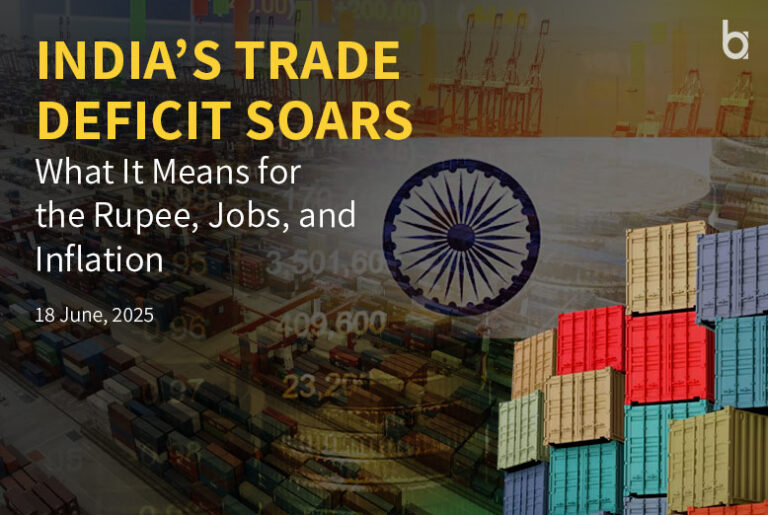Business APAC
June 18, 2025
The Indian Rupee is navigating turbulent waters as new government data released this week reveals India’s merchandise trade deficit ballooned to a seven-month high of $23.78 billion in May. This development, driven by a slump in exports and a rising import bill, comes at a time when domestic economic indicators, including persistent unemployment, are sending mixed signals, thereby intensifying pressure on the nation’s currency.
The Ministry of Commerce and Industry reported that while merchandise imports rose, exports contracted in May, widening the gap between the country’s payables and receivables. India’s growing trade deficit is a primary concern for currency markets, as it inherently increases the supply of the rupee in foreign exchange markets, which weighs on its value against major currencies, such as the US dollar.
Investment Climate and Currency Concerns
The performance of the Rupee is a critical barometer for foreign investors, who closely monitor the country’s economic fundamentals. A widening India’s trade deficit can be a red flag, suggesting potential macroeconomic instability. The Rupee has recently been trading near its all-time lows against the dollar, and a sustained trade imbalance could prevent any meaningful recovery.
“India’s trade deficit is a fundamental factor that directly impacts currency valuation,” explains Dr. Pronab Sen, former Chief Statistician of India. “When you are paying more for your imports in dollars than you are earning from exports, it naturally puts depreciatory pressure on the Rupee. This makes foreign investments more expensive to initiate and erodes the returns for existing investors when they repatriate profits.”
Compounding the issue is the domestic employment situation. While not directly linked to trade figures, data from the Centre for Monitoring Indian Economy (CMIE) indicates that unemployment has remained a persistent challenge, particularly among the youth and in urban centers. This underlying economic stress can dampen investor confidence and reduce the appetite for domestic assets.
Trade Deficit Adds to India’s Unemployment Challenges
As India’s trade deficit widens, the ripple effects are being felt beyond currency markets, reaching into the everyday struggles of the job market. Unemployment, especially among the youth and urban workforce, remains stubbornly high, underscoring deeper structural challenges.
With exports slowing and imports surging, key sectors that typically drive employment—like manufacturing and small-scale industries—are seeing reduced momentum. For millions of job seekers, the economic imbalance means fewer opportunities and growing uncertainty, compounding the pressure on policymakers to deliver both macroeconomic stability and tangible livelihoods.
The Balancing Act for Policymakers
The Reserve Bank of India (RBI) has been actively managing the Rupee’s volatility, but its options face constraints. Allowing the Rupee to weaken could help make exports more competitive, theoretically helping to close the India’s trade deficit. However, a weaker Rupee also inflates the cost of essential imports like crude oil and edible oils, which can fuel domestic inflation, a key concern for the central bank.
Commerce Secretary Sunil Barthwal acknowledged the global headwinds affecting exports, stating, “We are confident that we will be in the positive growth territory for exports. The global situation is improving, which will help our export momentum.”
Despite this optimism, the May figures highlight a vulnerability. Investors need a clear indication that India can control its trade deficit. This involves not just a recovery in global demand but also sustained policy support to bolster India’s manufacturing and export competitiveness.
Future Outlook
The interplay between global commodity prices will likely dictate the immediate future for the Indian Rupee, the strength of the US dollar, and India’s ability to boost its export figures in the coming months. A continued expansion of the India’s trade deficit could lead to further depreciation of the Rupee, potentially prompting more assertive action from the RBI.
Financial analysts will be closely watching the upcoming trade data for any signs of a reversal. Until a clear trend of a narrowing deficit emerges, currency and equity markets will likely remain cautious, with investors prioritizing stability before significantly investing in the Indian economy.
Also Read: India Gains Key Access to China’s Rare Earth Minerals



